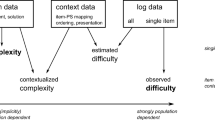Abstract
This chapter examines whether there is more to teaching students how to identify object-oriented (OO) concepts in domain analysis than has perhaps previously been appreciated. Understanding domain descriptions, expressed in natural language, in the early stages of software development is crucial to the success of a project. A study is presented which measured the performance of senior undergraduate computing students in terms of the types of errors they make as they tried to understand and identify important domain concepts. It concludes that the form of natural language used has an influence on the accuracy of a person's interpretation. In particular, students have a tendency to be confused by complex sentences and domain irrelevant information. In addition, students fail to notice important concepts indicated by infrequently appearing words.
Access this chapter
Tax calculation will be finalised at checkout
Purchases are for personal use only
Similar content being viewed by others
References
Booch, G. (1994). Object-Oriented Analysis and Design With Applications, Second Edition. Benjamin/Cummings, Redwood City, CA.
Brooks, J.F.P. (1987). No silver bullet — essence and accidents of software engineering. IEEE Computer, 20(4): 10–19.
Chen, P.P.-S. (1983). English sentence structure and entity relationship diagrams.. Information Sciences, 29: 127–149.
Cybulski, J.L. and Linden, T. (2000). Learning systems design with UML and patterns, IEEE Trans. Educ., 43(4), 372–376, Nov.
Delisle, S. Barker, K. Biskri, I. (1999). Object-Oriented Analysis: Getting Help from Robust Computational Linguistic Tools. 4th International Conference on Applications of Natural Language to Information Systems (OCG Schriftenreihe 129), Klagenfurt, Austria, pp. 167–171.
Elevator Problem, (2006). http://www.geocities.com/SiliconValley/Network/1582/uml-example.htm. Accessed 12 December.
Film Management, (2006). http://www.inf.unibz.it/̃calvanese/teaching/03-ESSLLI/ESSLLI-03-slides-1.pdf, accessed 12 December.
Goldin, L. and Berry, D.M. (1997). AbstFinder, A Prototype Natural Language Text Abstraction Finder for Use in Requirements Elicitation. Automated Software Engineering, 4(4):375–412, October.
Hadjerrouit, S. (2005). Learner-centered web-based instruction in software engineering, IEEE Trans. Educ., 48(1): 99–104, February.
Halliday, M.A.K. (2003). On Language and Linguistics, edited by J.J. Webster, Continuum, London/New York.
Jackson, M.A. (1994). The role of architecture in requirements engineering. Proc. IEEE International Conference on Requirements Engineering, p. 241, IEEE Computer Society.
Jacobson, I. Christerson, M. Jonsson, P. Overgaard, G. (1992). Object-Oriented Software Engineering: A Use Case Driven Approach. Addison-Wesley/ACM, Reading, MA.
Juristo, N. and Moreno, A.M. (2000). How to Use Linguistic Instruments for Object-Oriented Analysis, IEEE Software, May/June, pp. 80–89.
Korthaus, A. (1998). Using UML for business object based systems modeling. In M. Schader, and A. Korthaus (eds), The Unified Modeling Language — Technical Aspects and Applications, pp. 795–825, Heidelberg, Germany.
Kuhn, T. Royer, L. Fuchs, N. E. Schroeder, M. (2006). Improving Text Mining with Controlled Natural Language: A Case Study for Protein Interactions. In Ulf Leser, Barbara Eckman, and Felix Naumann, editors, Proceedings of the 3rd International Workshop on Data Integration in the Life Sciences (DILS'06), Lecture Notes in Bioinformatics, Springer, 2006.
Lecoeuche, R. (2000). Finding comparatively important concepts between texts. Proc. 15th IEEE International Conference on Automated Software Engineering, 11–15 September, pp.55–60.
Li, K. Dewar, R.G. Pooley, R.J. (2005). Towards Semi-automation in Requirements Elicitation: mapping natural language and object-oriented concepts, Proc. of the Doctoral Consortium at the 13th IEEE International Requirements Engineering Conference, Nancy A. Day (ed.), Paris, France, 29 August–2 September.
Loos, P. and Fettke, P. (2001). Towards an integration of business process modeling and object-oriented software development. Technical Report, Chemnitz University of Technology, Chemnitz, Germany.
Mentzas, G. (1999). Coupling object-oriented and workflow modeling in business and information reengineering. Information Knowledge and Systems Management, 1(1): 63–87.
Mich, L. (1996). NL-OOPs: From Natural Language to Object Oriented Using the Natural Language Processing System LOLITA. Natural Language Engineering, 2(2): 161–187.
Pooley, R.J. and Wilcox, P. (2004). Applying UML Advanced Application, Elsevier.
Rumbaugh, J. Blaha, M. Premerlani, W. Eddy, F. Lorensen, W. (1991). Object-Oriented Modeling and Design. Prentice Hall, Eaglewood Cliffs, NJ.
Svetinovic, D. Berry, D.M. Godfrey, M. (2005). Concept Identification in Object-Oriented Domain Analysis: Why Some Students Just Don't Get It, Proc. 13th IEEE International Conference on Requirements Engineering, Paris, France, 29 August–2 September.
Author information
Authors and Affiliations
Editor information
Editors and Affiliations
Rights and permissions
Copyright information
© 2009 Springer Science+Business Media, LLC
About this chapter
Cite this chapter
Li, K., Coady, J., Pooley, R., Dewar, R. (2009). Effects of Natural Language Complexity on Student Performance in Object-Oriented Domain Analysis. In: Barry, C., Lang, M., Wojtkowski, W., Conboy, K., Wojtkowski, G. (eds) Information Systems Development. Springer, Boston, MA. https://doi.org/10.1007/978-0-387-78578-3_18
Download citation
DOI: https://doi.org/10.1007/978-0-387-78578-3_18
Published:
Publisher Name: Springer, Boston, MA
Print ISBN: 978-0-387-78577-6
Online ISBN: 978-0-387-78578-3
eBook Packages: Computer ScienceComputer Science (R0)




